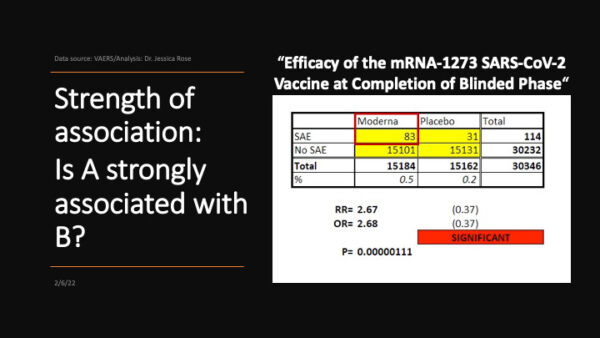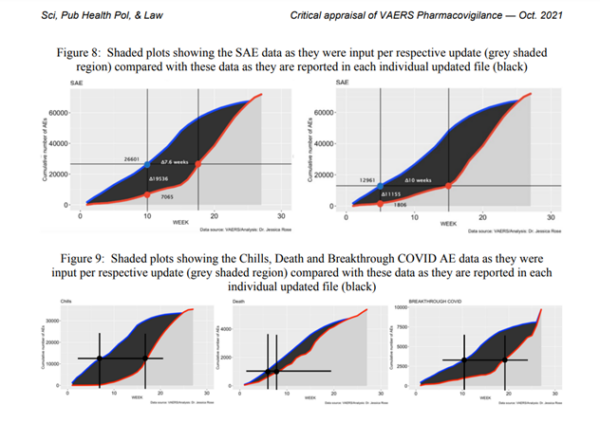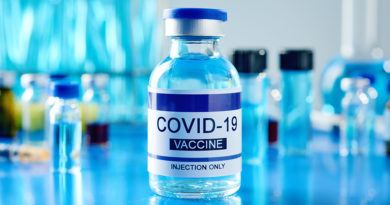COVID VAERS Inconsistencies: Backlogged Data, Causal Data, Data Removal
Dr. Jessica Rose is a Canadian molecular biologist. She was also trained in biostatistics during her PhD and hated it.
But since the vaccine rollouts over two years ago, she has been analyzing statistics every day.
“I really still loathe statistics,” Rose said, yet that hasn’t stopped her from analyzing the U.S. Vaccine Adverse Event Reporting System (VAERS) data, nor the South African VAERS equivalent.


What she has found are unprecedented reports in its quantity and the alarm.
To give an example, childhood dementia is a rare vaccine adverse event. Yet COVID-19 vaccines contributed to 11.2 percent of all dementia and related adverse events in children aged 6 to 17 on the VAERS database. In young adults aged 18 to 29, COVID-19 vaccines were related to 50.9 percent of all dementia and related adverse events.
Unprecedented Reports in Quantity and Alarm
“There are so many things in there [VAERS] that are rare, that are new: cancers that shouldn’t be happening in certain subsets of the population like ALL [acute lymphoblastic leukemia] in adults, male breast cancers, dementia in children … you name it,” Rose told The Epoch Times by phone.
ALL is a cancer condition that can affect all age groups but is the most common in children aged 0 to 14. There have also been reports of neuromyelitis in women in older age groups even though the condition mostly affects younger women.
Looking at VAERS as safety signals for the COVID vaccines alone, Rose said that “human physiology is seemingly at the mercy of whatever’s in these shots, particularly the mRNA shots, but not exclusively.”
Assuming that the vaccine was associated with the onset of these adverse events, Rose said she is completely baffled by what exactly is put into these vaccine vials to contribute to these events.
She gave the example of sudden adult death syndrome (SADS), which has been emerging and reported in several young athletes.
“I’m trying to wrap my brain around this, what … could you be injecting into people that would cause them to die quickly? It’s very weird to me, very weird. I have no answer to that question. I always think [that it could be] electricity. You’re seeing a lot of footage of athletes, and healthy young people, just dropping, they don’t even have time to cover their face [often a sign of neural impairment]. Something really switches off, and I can’t figure out what that is.”
Strong Evidence of Causation
Rose said that there is strong evidence of causation by simply looking at the VAERS data, alone.
But she conceded that “causation is a judgement call.”
“It’s important for everyone to understand that we can provide strong evidence of causal effects, but it’s always a judgement call on our part.”
Therefore, though causation can never be proven, evidence can always be collated to justify the decision to call a causation.
The common criteria used to evaluate causation is the Bradford Hill criteria: it is a list with 9 to 10 criteria that need to be satisfied, though causations can usually be called when five or six points are fulfilled.
The World Health Organization, only lists seven of the Bradford Hill criteria for causality. The authors of the report stated that the seven criteria are all relevant to assessing causality, though temporality is the most essential.
“One of the most important ones is temporality,” Rose said, this means that the adverse event has to follow the vaccination or whatever is administered, and the shorter the time frame, the stronger the association.
“Think of an acute reaction to a trigger like anaphylaxis,” Rose said, “if somebody gets injected with something, and within 15 minutes, they can’t breathe, or they’re having severe chest pain, or have some kind of cardiac event, there isn’t a human being on the planet who’s not going to say, oh, it’s because of the shot, or at least say it’s probably because of the shot.”
As of Sept. 29, 2022, the U.S. VAERS data shows that around 53.6 percent of all reported adverse events since the COVID-19 vaccine roll outs occurred between day 0 and day 1.


The other nine criteria include strength (association), specificity, consistency, dose response, plausibility, coherence, experiment, analogy, and reversibility.
At a video conference on the World Council for Health, Rose presented her findings of causal evidence for all 10 criteria.
Apart from temporality, another common criteria is strength. This tests the strength of the association between vaccination and adverse events. If a positive association exists, as vaccination increases, adverse events should also increase.
Rose tested this by comparing the number of severe adverse events between the vaccinated and the placebo group in the Moderna trials. Both groups had around 15,000 people.
In the supplementary appendix, the data showed that 83 people in the vaccinated group had severe adverse events as compared to 31 in the placebo group.
By putting these numbers in a Chi-square test, Rose found that there was a significance in the difference between the two groups.
“When you compare the number of severe adverse events in the drug arm—the mRNA 1273 arm—versus the placebo, you find a statistically significant difference between the two groups. You can see that the number of severe adverse event reports were actually higher in the drug arm,” Rose said on the video conference.


The P-value measured in a Chi-square test generally needs a number less than 0.05 to consider the association to be significant; the lower the number the greater the significance.
For the Moderna data, the P-value was less than 0.00001, showing a significant result with a strong association.
Another variable assessed is the R-value: it tests correlation, and the closer the R value is to 1, the stronger the correlation.
Rose found that the R-value between vaccination and severe adverse event in the Moderna trial to be 0.99, “which is a really high number.”
The authors of the Moderna study stated in the report that there was a greater number of severe adverse events between the placebo group and the vaccinated group, but in the discussion, they concluded that “no safety concerns were identified in this trial.”
Plausibility is another criterion: it tests if the theory of a causal relationship can be explained biologically.
The vaccine induces the cells to produce spike protein. There are already plenty of studies that indicate the harms of spike protein; if systematically present in the blood, it can cross the blood-brain system in rats.
Molecular biologists have also found that the spike protein have many regions that share similarities to proteins in humans, therefore, when the immune cell learns to attack the spike protein by also attacking these regions, the same immune cells invariably also learn how to kill their own cells, leading to tissue damage, and death.
Another criteria is specificity, meaning that specific age groups or races are more affected than others.
If there is no causality, we would expect the adverse events to be similar across all demographics, however, in the case of COVID-19 vaccinations, clustering of various adverse events are observed in certain age groups.
Perhaps one of the strongest evidence for specificity is the increased incidence of myocarditis in teenage and young adult males.
If the vaccine has no causal relationship at all with myocarditis, it is expected that all age groups will have the same rates of myocarditis; however, data shows that myocarditis risks are particularly high in young males, indicating a safety signal.
“It’s unknown why causality assessments [for myocarditis] are not being done … because I guarantee you, if they were being done the way that they’ve always traditionally been done, causality would have been proven, or strong evidence would have been provided to show evidence of causality in the context of the shots and myocarditis, and they would have been stopped, at least in young people.”
Backlogged and Removed Data
Between 2021 to 2022, the number of reports has fallen considerably from 620,478 reported adverse events from COVID-19 vaccines by the end of 2021, to 83,879 in 2022 as of Oct. 3, 2022.
However, Rose speculates the real number for 2022 could be much higher, given the rate of backlogs, and the data removal she has noticed.
In Rose’s peer-reviewed study evaluating the pharmacovigilance of VAERS data, Rose compared the VAERS data she downloaded from the CDC website every week (red line) to the most recent data downloaded from the CDC (blue line). The most recent data should contain all of the reported events from the beginning to now, and it is usually expected that the two lines would follow each other.
“But they don’t,” Rose said in her video published in September 2021.
Rose noted that the red and blue lines did not match each other in shape, and also had a large difference in numbers, constituted by the black gap between the lines.


the U.S. Vaccine Adverse Events Reporting System
(VAERS) a Functioning Pharmacovigilance System?” https://www.bibsonomy.org/bibtex/01b20290bc198e3ff717589bbdd32060/fordham1 (Courtesy of Dr. Rose)
Using data at week 10 as an example (top graph from the left), Rose commented that the weekly data at week 10 showed that there were more than 7,000 adverse events, whereas the most updated report showed that at week 10 there were actually more than 26,600 severe adverse event reports from later updates.
“This is a very large difference,” Rose said on the video, “especially when you consider what a severe adverse event is.”
“So what this means is that, a person who was watching the VAERS data [at week 10] and wondering to themselves, should I get this injection or not, would have seen this and [think] ‘there isn’t much risk according to this number,’ but the number hadn’t been correct because the data hadn’t been entered.”
All together, “I would say there’s like close to a million reports that haven’t been filled in yet,” Rose estimated.
Rose’s study also found that between Dec. 17 2020 to Aug. 6, 2021, there were 1,516 VAERS reports on COVID-19 vaccines removed without explanation.
“VAERS IDs can change because of an update or duplication, they can [also] be removed. But that’s different from VAERS IDs just simply going missing,” said Rose.
“I’m not saying I know why that’s happening. What I say is that if it is happening, there absolutely needs to be an account of why. There needs to be some kind of note saying, [this] VAERS ID and the number—because it’s a person, remember, it’s not just a number—has been removed from the VAERS database for this reason.”
At the time of Rose’s report, the total number of missing VAERS IDs for COVID-19 vaccines constituted 0.4 percent of all VAERS IDs.
Given that more than 1,500 reports were missing between the 33 weeks from Dec. 17, 2020 to Aug. 6, 2021, that means an average of 46 reports went missing every week.
“Every week there was an average between 30-50, to 100 reports that just were removed. It’s very strange,” said Rose.
And 69 percent of the removed adverse events reported during this period were severe adverse events; 13 percent of the removed data were death reports. The removed death data also constituted 3 percent of all death data in VAERS.
Of the removed death data, 59 percent were removed due to redundancy, though most missing data were not given an explanation.
“Something worth noting was the commonality in deleted entries where a causality relationship between the injections and the AE [adverse events] was not only implied but also suggested by the sender, which is typically the physician or emergency-room physician who attended to the individual’s case,” Rose wrote in the her article.


Bivalent Vaccine Data Inconsistencies
Two weeks after the COVID-19 bivalent booster vaccinations were added to the VAERS data system as a potential vaccine to report, adverse reports had already jumped to 550.
Rose said that in the first week, there were a bit more than 100 for the bivalent vaccine, and by the second week, it has increased by almost 500 percent to 550.
This increase is higher than the percentage increase between the first and second week of the initial vaccine rollouts.
Rose observed in late December when the first shots were rolled out, the first week of VAERS data showed 1,000 reports from the first COVID-19 shot, and the second week had 2,000, a 50 percent increase.
“We always need more data, but I’d say [from the data that the bivalent vaccines are] at least as risky [as the primary shots],” Rose said.
However, she said that the introduction of bivalent boosters for people who have already had their primary shots as well as follow-up boosters introduce a lot of confounding factors for her.
The bivalent shots are mostly targeted to people who have already had boosters, possibly taking the bivalent injection as their fourth, fifth, or sixth shots. Rose argued that their health would already be very compromised.
“From a data scientist’s point of view, it’s a nightmare, because you can’t draw a conclusion at all … If somebody dies one day after getting the bivalent shots, but they’re already on their fifth shot, we can’t say that that wasn’t because of the first four. There’s no way we could ever say the fifth shot killed them.”
Further, within the VAERS data, there are also people who are taking the bivalent injections as their first shots. This jumble of people who were boosted with people who are taking these as their primaries add further mess to the mix.
“People aren’t being asked to stick to one manufacturer,” she said. “Because that would make the data cleaner. If we did see safety signals coming out from a subset of people who have only had the Pfizer products, that would be much cleaner data, right? But they’re not promoting that at all, and I think it’s by design.”
The Epoch Times contacted the U.S. Centers for Disease Control and Prevention (CDC) and Moderna for comments.


